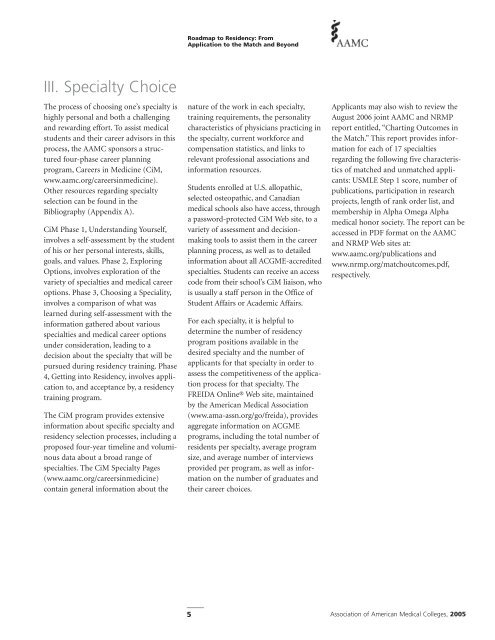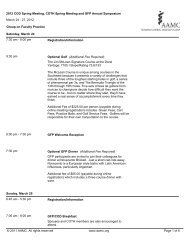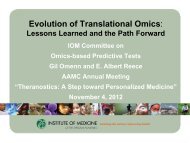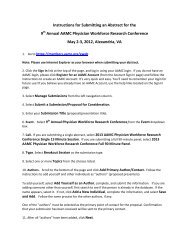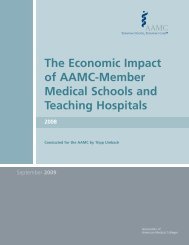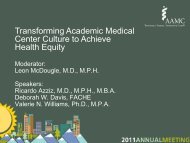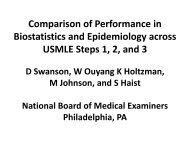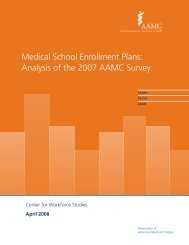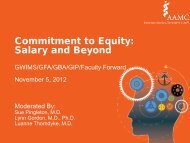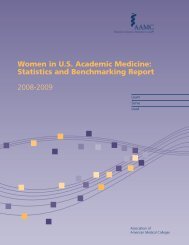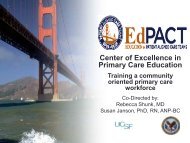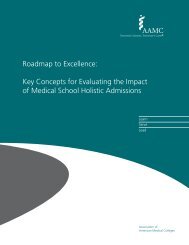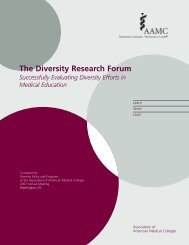Roadmap to Residency: - AAMC
Roadmap to Residency: - AAMC
Roadmap to Residency: - AAMC
You also want an ePaper? Increase the reach of your titles
YUMPU automatically turns print PDFs into web optimized ePapers that Google loves.
<strong>Roadmap</strong> <strong>to</strong> <strong>Residency</strong>: FromApplication <strong>to</strong> the Match and BeyondIII. Specialty ChoiceThe process of choosing one’s specialty ishighly personal and both a challengingand rewarding effort. To assist medicalstudents and their career advisors in thisprocess, the <strong>AAMC</strong> sponsors a structuredfour-phase career planningprogram, Careers in Medicine (CiM,www.aamc.org/careersinmedicine).Other resources regarding specialtyselection can be found in theBibliography (Appendix A).CiM Phase 1, Understanding Yourself,involves a self-assessment by the studen<strong>to</strong>f his or her personal interests, skills,goals, and values. Phase 2, ExploringOptions, involves exploration of thevariety of specialties and medical careeroptions. Phase 3, Choosing a Speciality,involves a comparison of what waslearned during self-assessment with theinformation gathered about variousspecialties and medical career optionsunder consideration, leading <strong>to</strong> adecision about the specialty that will bepursued during residency training. Phase4, Getting in<strong>to</strong> <strong>Residency</strong>, involves application<strong>to</strong>, and acceptance by, a residencytraining program.The CiM program provides extensiveinformation about specific specialty andresidency selection processes, including aproposed four-year timeline and voluminousdata about a broad range ofspecialties. The CiM Specialty Pages(www.aamc.org/careersinmedicine)contain general information about thenature of the work in each specialty,training requirements, the personalitycharacteristics of physicians practicing inthe specialty, current workforce andcompensation statistics, and links <strong>to</strong>relevant professional associations andinformation resources.Students enrolled at U.S. allopathic,selected osteopathic, and Canadianmedical schools also have access, througha password-protected CiM Web site, <strong>to</strong> avariety of assessment and decisionmaking<strong>to</strong>ols <strong>to</strong> assist them in the careerplanning process, as well as <strong>to</strong> detailedinformation about all ACGME-accreditedspecialties. Students can receive an accesscode from their school’s CiM liaison, whois usually a staff person in the Office ofStudent Affairs or Academic Affairs.For each specialty, it is helpful <strong>to</strong>determine the number of residencyprogram positions available in thedesired specialty and the number ofapplicants for that specialty in order <strong>to</strong>assess the competitiveness of the applicationprocess for that specialty. TheFREIDA Online® Web site, maintainedby the American Medical Association(www.ama-assn.org/go/freida), providesaggregate information on ACGMEprograms, including the <strong>to</strong>tal number ofresidents per specialty, average programsize, and average number of interviewsprovided per program, as well as informationon the number of graduates andtheir career choices.Applicants may also wish <strong>to</strong> review theAugust 2006 joint <strong>AAMC</strong> and NRMPreport entitled, “Charting Outcomes inthe Match.” This report provides informationfor each of 17 specialtiesregarding the following five characteristicsof matched and unmatched applicants:USMLE Step 1 score, number ofpublications, participation in researchprojects, length of rank order list, andmembership in Alpha Omega Alphamedical honor society. The report can beaccessed in PDF format on the <strong>AAMC</strong>and NRMP Web sites at:www.aamc.org/publications andwww.nrmp.org/matchoutcomes.pdf,respectively.5Association of American Medical Colleges, 2005


